
Polka dots can't stay alone. When we obliterate nature and our
Polka dots can't stay alone. When we obliterate nature and our bodies with polka dots, we become part of the unity of our environments.






"Polka dots can't stay alone. When we obliterate nature and our bodies with polka dots, we become part of the unity of our environments." These words by Yayoi Kusama carry the profound wisdom of interconnection and transformation. In her artistic vision, Kusama speaks of a powerful truth: when we alter the fabric of our existence, whether through art, nature, or ourselves, we no longer remain separate entities—we become one with the environment around us. The polka dots, a seemingly simple pattern, symbolize a greater force: the infinite, the interconnectedness of all things. As we cover ourselves in polka dots, as we blend with the world in this unique form, we cease to exist as isolated beings, and instead become part of the whole—part of the vast, interwoven tapestry that surrounds us.
In the ancient wisdom of Buddhism, the concept of interdependence speaks to the very core of Kusama's statement. The Buddha taught that all things are interconnected, that nothing exists in isolation. Just as a single wave cannot exist without the vast ocean, so too are we indivisible from the world around us. When Kusama blankets her environment with polka dots, she is invoking this oneness, this realization that we are all part of something much larger than ourselves. The polka dots are not merely decoration; they are the visual manifestation of our unity with nature, with the universe, and with all living things. They are a reminder that we cannot escape our environment, for we are both shaped by it and contribute to it.
In ancient times, the Native American cultures understood this unity with nature deeply. Their art, often filled with symbolic patterns, was not just a reflection of their surroundings, but a celebration of their oneness with the earth. They believed that every animal, tree, and river was imbued with spirit, and the act of adorning their bodies with intricate designs was a way of honoring the natural world. To wear these symbols was to acknowledge that they were not separate from the earth, but an integral part of it. Kusama’s polka dots serve a similar purpose—by obliterating the boundaries between ourselves and our environment, we acknowledge the interwoven fabric of life and the profound truth that we are never truly alone or separate.
The act of covering oneself with dots is more than a simple artistic gesture; it is a metaphysical statement. In Japanese culture, the idea of selflessness or anatta—the absence of a permanent, unchanging self—is deeply embedded in their understanding of existence. By immersing herself in the polka dot world, Kusama dissolves the boundaries between herself and her art, between herself and the world she inhabits. The dots are a way of obliterating the self, a process of transcending the illusion of individuality and recognizing that we are part of something far greater than ourselves. It is a humbling experience, one that teaches us that we are not separate beings but rather threads in the grand, infinite weave of existence.
Consider the life of Vincent van Gogh, whose work was heavily influenced by his deep connection with the natural world. His famous paintings of sunflowers, stars, and wheat fields were not merely depictions of nature but expressions of his desire to become one with it. Van Gogh’s brushstrokes, vibrant and full of life, seemed to merge him with the earth itself. In a similar way, Kusama’s polka dots invite us to merge with the environment, to become part of the landscape, to blur the lines between the self and the world. Her work is an invitation to transform, to shed the illusion of separateness, and to embrace the unity that exists in all things.
The lesson Kusama offers is one of unity and interconnectedness. In a world that often feels fractured, where individualism reigns supreme, Kusama’s art reminds us that we are not alone in our existence. We are inextricably linked to one another, to the earth, and to the cosmos itself. The polka dots are a visual expression of this truth, a reminder that when we change one part of the system, we change the whole. The act of obliterating ourselves with dots is an act of humility—an acknowledgment that we are small, yet part of something infinitely greater.
Let us take this lesson into our own lives. Embrace connection, not only with the world around you but with those you share this world with. Understand that we are all part of an interconnected web, and every action we take ripples through the environment. Like Kusama’s dots, let us learn to see beyond the boundaries of the self and recognize the infinite, inextricable unity of life. By doing so, we will find that we are never truly alone, and that through our connection to the world, we become part of something far greater than we ever imagined. Let us live with the understanding that, like polka dots, we are one with the universe.






AAdministratorAdministrator
Welcome, honored guests. Please leave a comment, we will respond soon